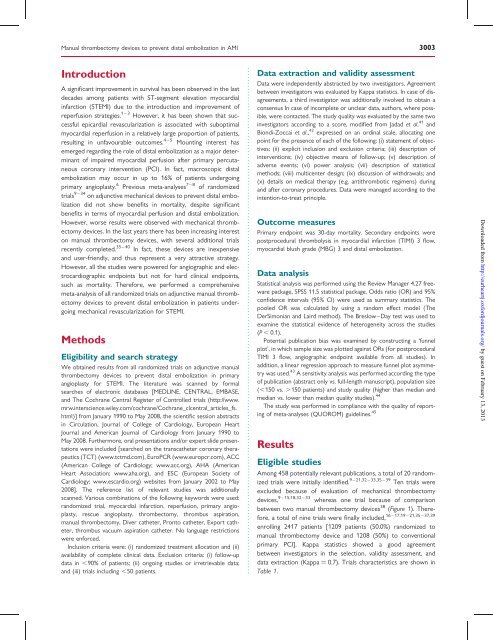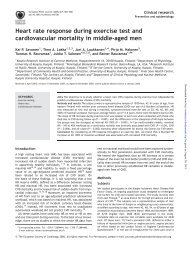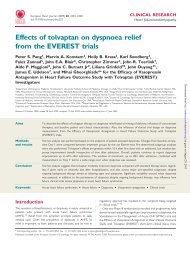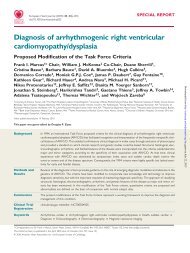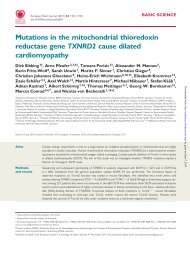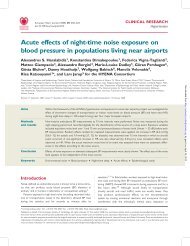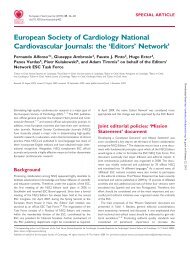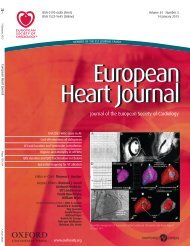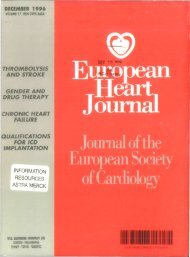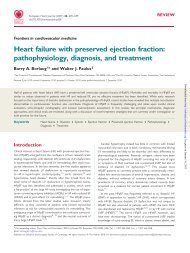Adjunctive manual thrombectomy improves myocardial perfusion ...
Adjunctive manual thrombectomy improves myocardial perfusion ...
Adjunctive manual thrombectomy improves myocardial perfusion ...
Create successful ePaper yourself
Turn your PDF publications into a flip-book with our unique Google optimized e-Paper software.
Manual <strong>thrombectomy</strong> devices to prevent distal embolization in AMI 3003<br />
Introduction<br />
A significant improvement in survival has been observed in the last<br />
decades among patients with ST-segment elevation <strong>myocardial</strong><br />
infarction (STEMI) due to the introduction and improvement of<br />
re<strong>perfusion</strong> strategies. 1–3 However, it has been shown that successful<br />
epicardial revascularization is associated with suboptimal<br />
<strong>myocardial</strong> re<strong>perfusion</strong> in a relatively large proportion of patients,<br />
resulting in unfavourable outcomes. 4–5 Mounting interest has<br />
emerged regarding the role of distal embolization as a major determinant<br />
of impaired <strong>myocardial</strong> <strong>perfusion</strong> after primary percutaneous<br />
coronary intervention (PCI). In fact, macroscopic distal<br />
embolization may occur in up to 16% of patients undergoing<br />
primary angioplasty. 6 Previous meta-analyses 7–8 of randomized<br />
trials 9–34 on adjunctive mechanical devices to prevent distal embolization<br />
did not show benefits in mortality, despite significant<br />
benefits in terms of <strong>myocardial</strong> <strong>perfusion</strong> and distal embolization.<br />
However, worse results were observed with mechanical <strong>thrombectomy</strong><br />
devices. In the last years there has been increasing interest<br />
on <strong>manual</strong> <strong>thrombectomy</strong> devices, with several additional trials<br />
recently completed. 35 – 40 In fact, these devices are inexpensive<br />
and user-friendly, and thus represent a very attractive strategy.<br />
However, all the studies were powered for angiographic and electrocardiographic<br />
endpoints but not for hard clinical endpoints,<br />
such as mortality. Therefore, we performed a comprehensive<br />
meta-analysis of all randomized trials on adjunctive <strong>manual</strong> <strong>thrombectomy</strong><br />
devices to prevent distal embolization in patients undergoing<br />
mechanical revascularization for STEMI.<br />
Methods<br />
Eligibility and search strategy<br />
We obtained results from all randomized trials on adjunctive <strong>manual</strong><br />
<strong>thrombectomy</strong> devices to prevent distal embolization in primary<br />
angioplasty for STEMI. The literature was scanned by formal<br />
searches of electronic databases [MEDLINE, CENTRAL, EMBASE,<br />
and The Cochrane Central Register of Controlled trials (http://www.<br />
mrw.interscience.wiley.com/cochrane/Cochrane_clcentral_articles_fs.<br />
html)] from January 1990 to May 2008, the scientific session abstracts<br />
in Circulation, Journal of College of Cardiology, European Heart<br />
Journal and American Journal of Cardiology from January 1990 to<br />
May 2008. Furthermore, oral presentations and/or expert slide presentations<br />
were included [searched on the transcatheter coronary therapeutics<br />
(TCT) (www.tctmd.com), EuroPCR (www.europcr.com), ACC<br />
(American College of Cardiology; www.acc.org), AHA (American<br />
Heart Association; www.aha.org), and ESC (European Society of<br />
Cardiology; www.escardio.org) websites from January 2002 to May<br />
2008]. The reference list of relevant studies was additionally<br />
scanned. Various combinations of the following keywords were used:<br />
randomized trial, <strong>myocardial</strong> infarction, re<strong>perfusion</strong>, primary angioplasty,<br />
rescue angioplasty, <strong>thrombectomy</strong>, thrombus aspiration,<br />
<strong>manual</strong> <strong>thrombectomy</strong>, Diver catheter, Pronto catheter, Export catheter,<br />
thrombus vacuum aspiration catheter. No language restrictions<br />
were enforced.<br />
Inclusion criteria were: (i) randomized treatment allocation and (ii)<br />
availability of complete clinical data. Exclusion criteria: (i) follow-up<br />
data in ,90% of patients; (ii) ongoing studies or irretrievable data;<br />
and (iii) trials including ,50 patients.<br />
Data extraction and validity assessment<br />
Data were independently abstracted by two investigators. Agreement<br />
between investigators was evaluated by Kappa statistics. In case of disagreements,<br />
a third investigator was additionally involved to obtain a<br />
consensus In case of incomplete or unclear data, authors, where possible,<br />
were contacted. The study quality was evaluated by the same two<br />
investigators according to a score, modified from Jadad et al. 41 and<br />
Biondi-Zoccai et al., 42 expressed on an ordinal scale, allocating one<br />
point for the presence of each of the following: (i) statement of objectives;<br />
(ii) explicit inclusion and exclusion criteria; (iii) description of<br />
interventions; (iv) objective means of follow-up; (v) description of<br />
adverse events; (vi) power analysis; (vii) description of statistical<br />
methods; (viii) multicenter design; (ix) discussion of withdrawals; and<br />
(x) details on medical therapy (e.g. antithrombotic regimens) during<br />
and after coronary procedures. Data were managed according to the<br />
intention-to-treat principle.<br />
Outcome measures<br />
Primary endpoint was 30-day mortality. Secondary endpoints were<br />
postprocedural thrombolysis in <strong>myocardial</strong> infarction (TIMI) 3 flow,<br />
<strong>myocardial</strong> blush grade (MBG) 3 and distal embolization.<br />
Data analysis<br />
Statistical analysis was performed using the Review Manager 4.27 freeware<br />
package, SPSS 11.5 statistical package. Odds ratio (OR) and 95%<br />
confidence intervals (95% CI) were used as summary statistics. The<br />
pooled OR was calculated by using a random effect model (The<br />
DerSimonian and Laird method). The Breslow–Day test was used to<br />
examine the statistical evidence of heterogeneity across the studies<br />
(P , 0.1).<br />
Potential publication bias was examined by constructing a ‘funnel<br />
plot’, in which sample size was plotted against ORs (for postprocedural<br />
TIMI 3 flow, angiographic endpoint available from all studies). In<br />
addition, a linear regression approach to measure funnel plot asymmetry<br />
was used. 43 A sensitivity analysis was performed according the type<br />
of publication (abstract only vs. full-length manuscript), population size<br />
(,150 vs. .150 patients) and study quality (higher than median and<br />
median vs. lower than median quality studies). 44<br />
The study was performed in compliance with the quality of reporting<br />
of meta-analyses (QUOROM) guidelines. 45<br />
Results<br />
Eligible studies<br />
Among 458 potentially relevant publications, a total of 20 randomized<br />
trials were initially identified. 9 – 21,32 – 33,35 – 39 Ten trials were<br />
excluded because of evaluation of mechanical <strong>thrombectomy</strong><br />
devices, 9 – 15,18,32 – 33 whereas one trial because of comparison<br />
between two <strong>manual</strong> <strong>thrombectomy</strong> devices 38 (Figure 1). There-<br />
16 – 17,19 – 21,35 – 37,39<br />
fore, a total of nine trials were finally included,<br />
enrolling 2417 patients [1209 patients (50.0%) randomized to<br />
<strong>manual</strong> <strong>thrombectomy</strong> device and 1208 (50%) to conventional<br />
primary PCI]. Kappa statistics showed a good agreement<br />
between investigators in the selection, validity assessment, and<br />
data extraction (Kappa ¼ 0.7). Trials characteristics are shown in<br />
Table 1.<br />
Downloaded from<br />
http://eurheartj.oxfordjournals.org/ by guest on February 13, 2013


